Using Apocalypse World to Outline and Draft Your Own RPG
Here in Part 11, I explore a few of the dice systems we’ve used in our games.
This article was made possible by the generous support of our patrons. Please consider joining them by supporting us on Patreon.
Dice: an Accident of the System
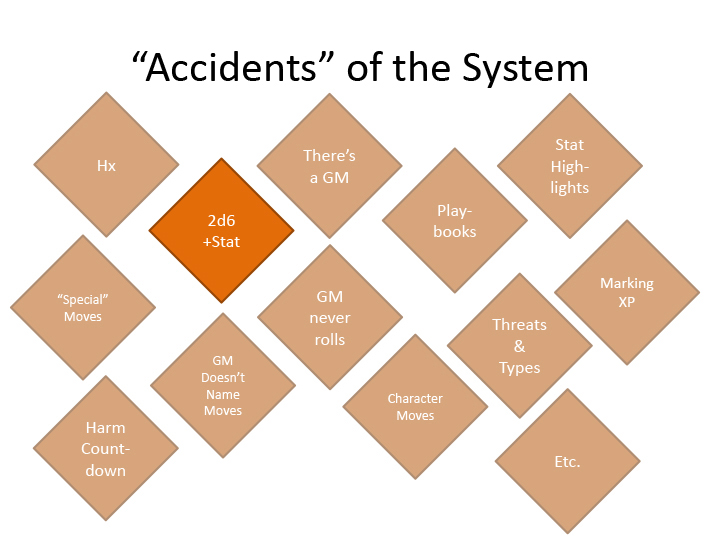
Back in Part 1, I said that rolling 2d6 + a stat was an “accident” of PbtA — a feature which has become common in PbtA games, but which was just how we happened to do it in Apocalypse World. You can and should consider carefully whether following Apocalypse World is the best design decision for your own games.
As it happens, we’ve made a variety of PbtA games after Apocalypse World ourselves, and I think that only one of them, Under Hollow Hills, has stuck with the modified 2d6 roll. The rest have their own dice systems (or none), because they’re different games with different needs.
Let’s go through them!
Apocalypse World & Under Hollow Hills
In Apocalypse World, you roll 2d6 and add one of your stats, depending on the move you’re making. Your stats can range from -2 to +3, but generally fall from -1 to +2, averaging to roughly +1.
Each move lists three results: a total of 10+ is a strong hit, a total of 7–9 is a weak hit, and a total of 6 or less is a miss.
Under Hollow Hills follows this same pattern, except that it does away with the stats. Instead, you have a modifier for each of your moves — in this game called “plays,” as in “are you making a play for it? How are you going to play this? Playing it safe?” Your modifiers still range from -2 to +3, but usually from -1 to +2, and average to roughly +1; and the plays still list results for 10+ (a strong play), 7–9 (a weak play), and 6 or less (a misplay).
Here’s how the odds look:
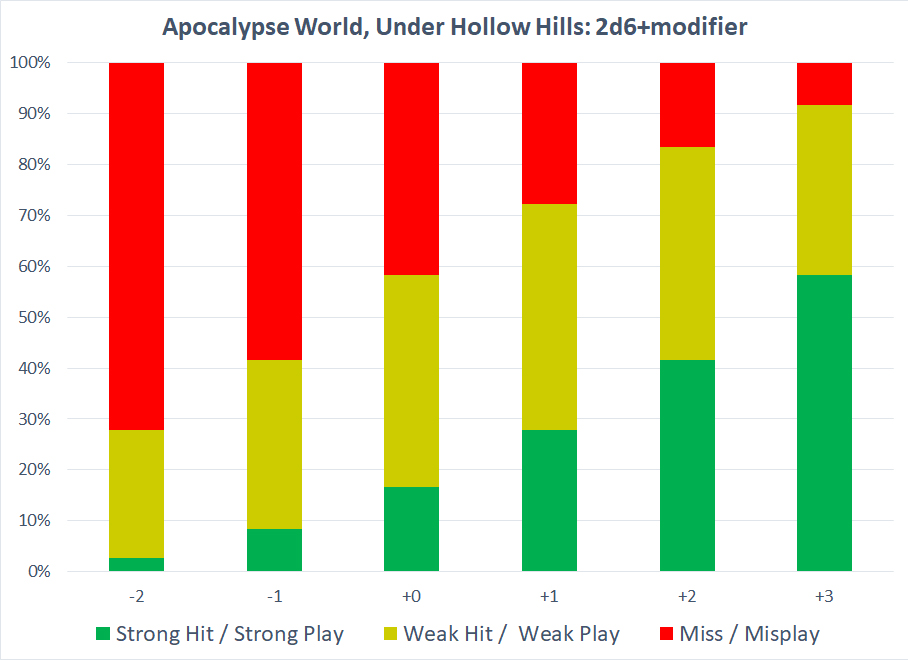
Hey Vincent, why are the results 10+ / 7–9 / 6 or less, instead of the more obvious and symmetrical 9+ / 6–8 / 5 or less?
Here’s my answer to this question from Part 7:
In Apocalypse World, the average stat is +1. This is a bit of sleight-of-hand to make you feel badass: putting the stats on a -2 to +2 scale makes +0 feel like the average, so giving you stats that actually average to +1 makes you feel above average.
Since your stats average to +1, I centered the result curve on 8 instead of 7.
Giving you stats that actually average to +0, and centering the result curve on 7, would have given the game a more rationalist, constrained, moderated tone, where I was going for something more cinematic, expressionist, and over-the-top.
Here’s an example of a move from Apocalypse World:
Eye on the door: name your escape route and roll+cool. On a 10+, you’re gone. On a 7–9, you can go or stay, but if you go it costs you: leave something behind or take something with you, the MC will tell you what. On a miss, you’re caught vulnerable, half in and half out.
Here’s an example of a play from Under Hollow Hills:
When you seek out the little wild things, roll. On any hit, ask questions; the MC must answer them truthfully. On a 10+ hit, ask 3. On a 7–9 hit, ask 2.
• What news from the little wild birds?
• What news from the bee clans?
• What news from the beetles and worms?
• What news from the star-chasing night winds?
• …
On a miss, in seeking out the little wild things, you’ve blundered into a hunter. Ask the MC where you are and what’s doing.
Advantage Die vs +1Forward
Apocalypse World has a mechanic called “+1forward,” where the results of one move might include a +1 bonus to your next move. Some PbtA games since then have replaced the +1 with an “advantage die,” where you roll three dice instead of two, discarding the lowest.
Here’s how the odds compare:
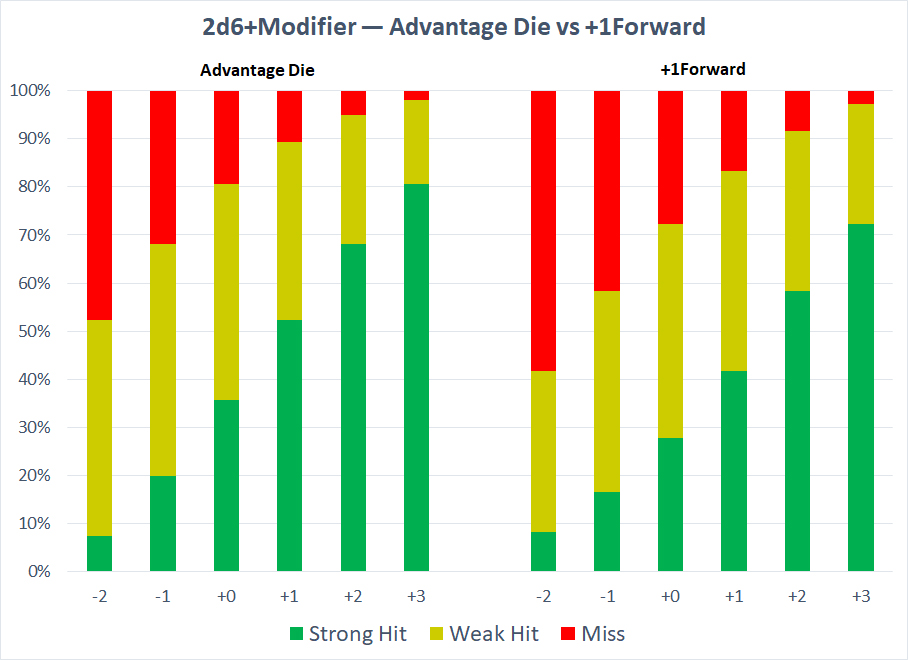
You can see that the advantage die gives the bigger bonus.
Murderous Ghosts
We published Murderous Ghosts in 2011, our first PbtA game after Apocalypse World. You’re an urban explorer trapped in a haunted factory (originally) or Victorian hotel (more recently) with murderous ghosts. Your goal in the game is to escape unmurdered. Can you do it?
(Probably not.)
Murderous Ghosts doesn’t use dice at all, it uses cards. At turning points in the developing story, you draw a card into your hand. You start with an empty hand, and each time you draw a card, you sum your cards to determine the result, like in Blackjack. Aces add 1; all face cards add 11. Like moves in Apocalypse World, draws have three possible outcomes:
- A sum of 0–5, or a sum of 21+, is a bust. The worst possible thing happens.
- A sum of 6–12 means that you’re in danger.
- A sum of 13–20 means that you’re safe.
When you bust, you discard your hand and start over (if you live through it). You can also discard your hand and start over before any draw, if you think it’s too risky.
Here’s how the odds look, approximately, depending on the current value of your hand:
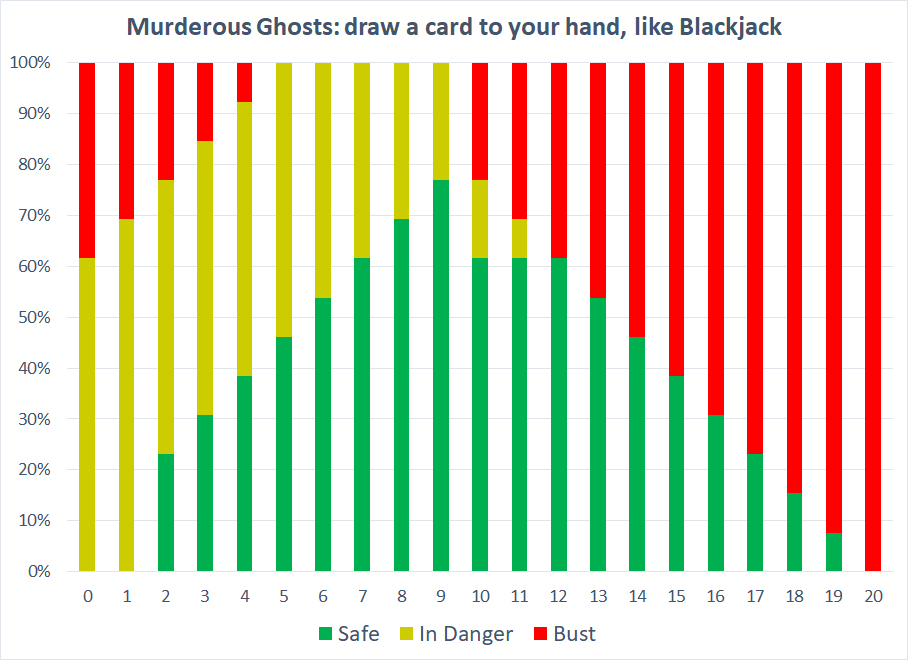
Here’s an example of a draw from Murderous Ghosts:
What do you most hope the ghost doesn’t do?
• Look at me.
• Reach out to me.
• Speak.
• Stop still.
Draw.
13–20: It does none of them.
6–12: It does one of the others. Choose which and tell the MC.
Bust: It does the one you hoped it wouldn’t. Tell the MC which.
Since your hands are persistent, the game’s card cycle creates a rhythm:
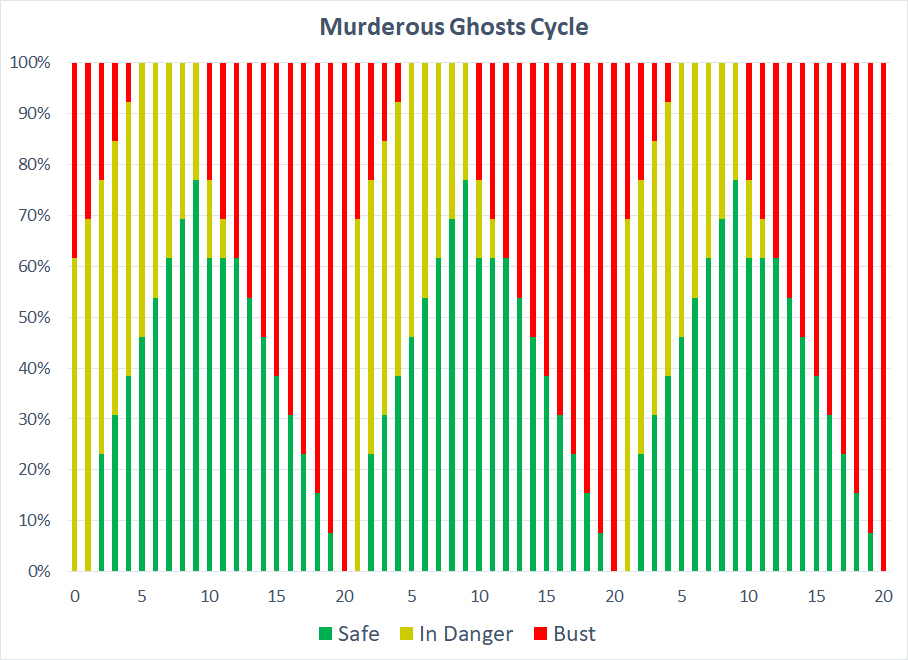
It’s a game of push-your-luck. To play Murderous Ghosts skillfully, you need to time your draws: try to make those risky draws when your character’s safe, and try to make your safe draws when your character’s at risk.
The Sundered Land
We published The Sundered Land in 2013. It’s a suite of postcard-sized games, each one featuring just one situation and just one die-rolling move, set in “the Sword & Sorcery ruins of the future.” The games are like, I’m a warrior seeking peace and an end to bloodshed, on a doomed pilgrimage through dangerous lands; we’re caravan guards and the caravan’s come under attack by a strange and menacing enemy; we’re keeping night watch, trading stories about our pasts; and so on.
The Sundered Land games don’t use any stats or modifiers, just a straight 2d6 roll. Because of this, Apocalypse World’s 10+ / 7–9 / 6 or less breakdown of outcomes would be too punishing — it depends, recall, on an average modifier of +1. The Sundered Land uses a 9-12 / 6–8 / 2-5 breakdown to get the same odds:
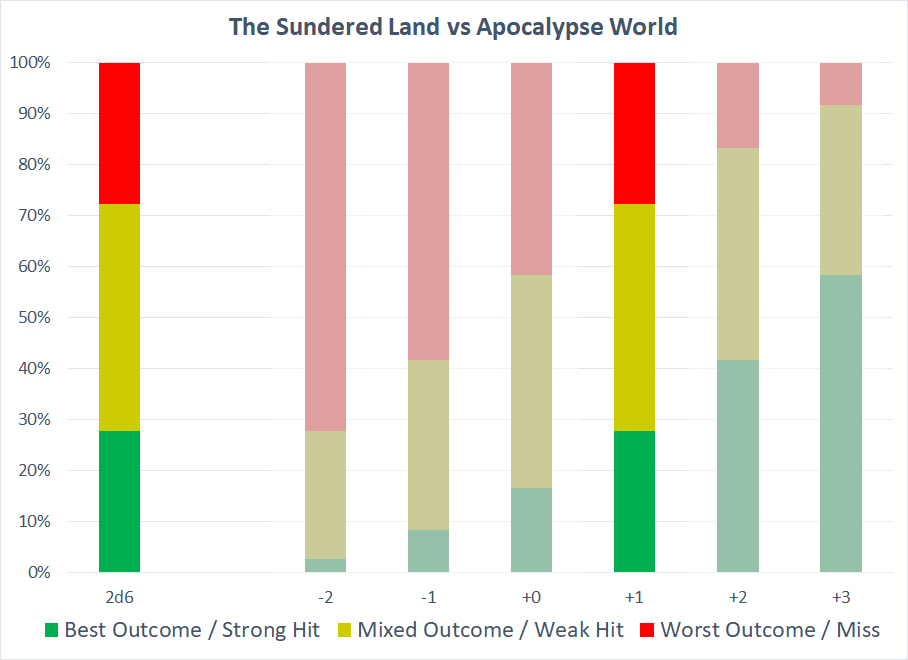
Here’s an example of a roll from the Sundered Land, from Caravan Guards:
Whenever your character does something that would bring you into conflict with someone or expose you to danger, anyone may call for a roll. Roll 2 dice.
2-5: It might go terribly wrong: You get one chance to say how you get help or hold it together on your own. Everyone else votes thumbs-up or thumbs-down. If the thumbs-downs win, say how it goes wrong, and how you’re hurt, thrown, killed, seized, or laid low. If it’s still possible for you to accomplish what you hoped, you do, and the Hazard player says the rest.
6-8: It might reveal something: Ask if anyone has insights into what’s happening. If anybody does, the Hazard player decides whether they’re right. Either way, you accomplish what you hoped, and the Hazard player says what happens.
9-12: You might overreach: You accomplish what you hoped, the Hazard player says what happens, and you might seize further advantage. Anybody can describe how you can carry your advantage forward, and you choose whether to take the chance or let it pass. But first, the hazard player decides in secret whether you’ll be overreaching yourself, and reveals it if you do.
MF0:Firebrands & The King Is Dead
Mobile Frame Zero: Firebrands is a game about the messy lives of ace mecha pilots in a space colony on the brink of war. The King Is Dead is a game about the messy lives of rival heirs for a contested throne in a fantasy kingdom. We published them in 2017 and 2019, respectively.
They’re romance games. The conflicts in the game are social, not success-oriented; you’re playing to get to know the other characters and make relationship messes, not to defeat each other as enemies, outdo each other as rivals, or work together to accomplish your goals.
They don’t use dice (or cards) for resolution. Instead they get uncertain outcomes from the process of asking and answering questions. They also don’t use the 3-tier hits and misses system.
For example, here are the questions from one of The King Is Dead’s moves, the Reunion:
The opening question:
• When did we last see each other?
Reunion questions:
• We were so close then and I’m happy and eager to see you now. Do you greet me warmly or coolly?
• We parted on bad terms and I’m nervous to see you now. Do you smile?
• I was so in love with you then and I wonder if I’ll still feel it. Are you still as [here name an attractive quality] now as you were then?
• In those days we fought and gibed, but I always trusted you, and I wonder whether I can trust you still. Do you give me the old secret look?
• I used to worship you and dog your heels, and I’m concerned you’ll still see me that way. Do you greet me as an equal now, or subtly dismiss me?
• It’s been so long that I’m sure you’ll hardly remember me. Are you surprised by what you see?
…And so on.
There’s no way to graph the odds of how they’ll answer!
The Wizard’s Grimoire
The Wizard’s Grimoire is a series of zine games that we’ve been publishing since 2019:
- The Wizard’s Grimoire
- The Barbarian’s Bloody Quest
- The Last Adventure
- The Thief & the Necromancer
- The Wizard’s Library
…And more to come.
These games call their moves “exertions.” Instead of rolling 2d6 plus a modifier, you roll a d6 pool and count the dice that come up 4–6 as hits. There aren’t result bands; instead, each hit you roll gives you an option, a chance, or a better outcome directly, one for one.
If you roll no hits at all, that’s a miss.
You might be interested to know that Apocalypse World’s immediate predecessor, a game we never published called “Storming the Wizard’s Tower,” in which we drafted the first versions of several of Apocalypse World’s moves, worked the same way. The original versions of reading a situation, reading a person, seizing by force, and others — they didn’t use success bands, you just got to choose a question or an option for each hit you rolled.
Anyway, here are the odds:
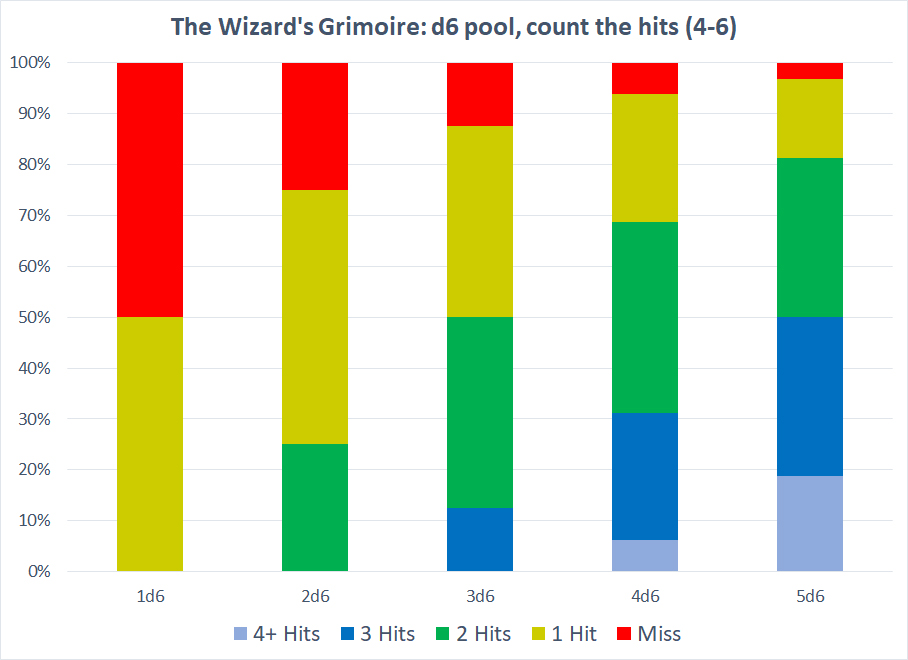
Here’s an example of an exertion from The Wizard’s Grimoire:
You can submit to circumstance, trying to come out on your feet.
At the end of this, you’re going to ask where you wind up and what state you’re in when you get there, but first roll. Choose one per hit:
• I keep my feet.
• I keep my bearings.
• I keep my life.
• I keep my senses.
• I keep my grip.
• I keep my dignity.
• I keep my self-control.
• I keep my self-respect.
• &c as necessary.
Before you choose, you can ask just how badly it might go, and make your choices accordingly.
On a miss, choose one, but it’s “I can’t keep…”
Say which you’ve chosen and ask, given that, where you wind up and what state you’re in when you get there.
The Wolf King’s Son
The Wolf King’s Son is a game set in the same, I guess, world as Under Hollow Hills. We’re in the immediate process of publishing it as I write this.
In it, your father is the fairytale figure the Wolf King of Winter, for good and bad. You left his court with hard words, and now you’re making your own way, with your questionable friends, through fairyland. It’s based on an earlier game called “The True and Preposterous Journey of Half-a-Fool.”
In early playtesting, we discovered something pretty interesting about these games. They don’t call for misses in their moves at all, just strong plays and weak plays. This means that they don’t call for the 2d6 curve, either. In the Wolf King’s Son, you roll 1d6, modified by -1 to +3 depending on the play. A roll of 5 or better is a strong play; 4 or less is a weak play.
Here’s how the odds look, straightforward as anything:
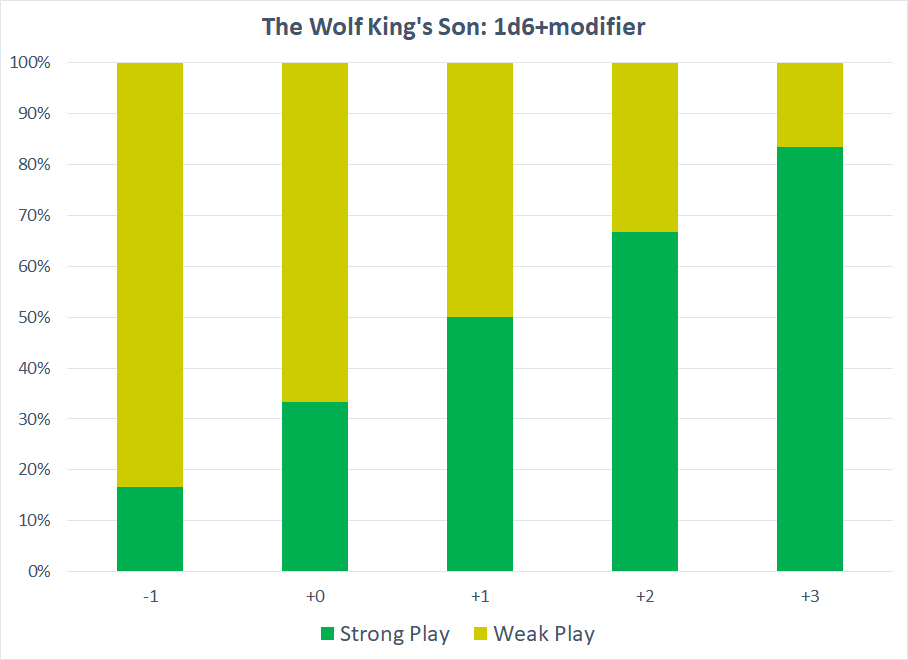
Here’s an example of a play from The Wolf King’s Son:
Resorting to Violence
If you confront someone and they defy you, or if you roll a weak play and don’t like how it turns out, you can resort to violence.
On a strong play of 5 or more, have them choose one of the following for you:
• I gain the upper hand and they flee.
• I gain the upper hand and they submit to my mercy.
• I hurt or frighten them badly and they flee.
• I’m able to hold them off until [x] happens.
On a weak play of 4 or less, mark danger, and they gain the upper hand over you. Ask whether they beat you and leave you for dead, take you captive, drive you away, or what.
The Demon Tree (Working Title)
The Demon Tree is the working title of a game I’m making with my 18-year-old design partner Tovey. It’s vivid and phantasmagorical, a much younger person’s take on fantasy than my usual Vance, Leiber and Lee-inspired Sword & Sorcery.
When you take action, you roll a pool of 1 to 6 dice, depending on your stat, and sum the highest two. The actions’ outcomes start with Apocalypse World’s tiers, but add more at the top: 6 or less is a miss, 7–9 is a weak hit, 10–11 is a strong hit, 12 is an excellent hit, and 13+ is an exceptional hit.
Yes, if you’re rolling only 1 die, you can only roll a miss, and the only way to get an exceptional hit is to roll high and then spend enough experience to push your roll up to a 13+.
The odds look like this:
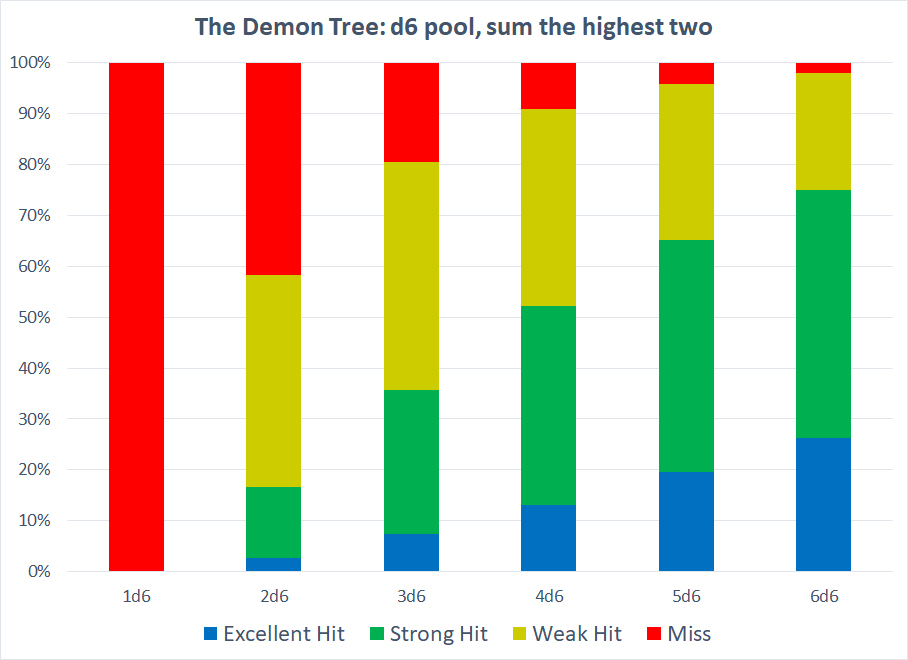
The actions in the Demon Tree fall into two broad modes: low-stakes actions and high-stakes actions.
In low-stakes action, a weak hit of 7–9 is fine, and a strong hit of 10+ is great. These are actions like reading a situation, spending time with someone, or preparing yourself for what’s coming.
Here’s an example:
When you’re uncertain of someone, you can size them up with a calculating eye. Roll your highest stat. On any hit, ask 1:
• How far are they willing to go, and how can I tell?
• What do they think of me, and how do they show it?
• What are they planning to do, and what gives it away?
• Something’s off with them. What makes me think so?
• I suspect that they’re hiding something. Can I guess what? How?
• A question of your own. If they answer it, it stands.
On 10+, ask 1 or 2 more, or else choose to hold the initiative: what next?
Otherwise, pass the initiative.
In high-stakes action, a strong hit of 10–11 might be good enough, but an excellent hit of 12 is definitely better, and you might even need an exceptional hit of 13+ to succeed. These are actions like getting to work to accomplish something crucial and difficult, or doing battle with a dangerous demon.
Here’s an example:
When you attack an enemy, explain what you’re trying to do, then roll your Violent. Tell the GM your roll. Generally:
• If you don’t beat your enemy’s readiness, they’re able to interrupt you before you can make your attack;
• You can land your blow only if you beat their active defense; and
• The effect of landing a blow depends on the details of your attack, your weapon, their armor, etc.
The GM’s only obliged to tell you what happens, not your enemy’s stats directly.
(Note that a demon can easily have a readiness of 7 or 8 and an active defense of 11 or 12, meaning that it can interrupt your attack on a roll of 2–7 or 2–8, and only a roll of 12 or 13 will let you land a blow.)
When the stakes are low, the game plays like Apocalypse World: the characters are quite competent and effective, with enough variety in their levels of success to keep things dynamic. When things turn deadly, that’s when it takes quick thinking, luck, persistence, teamwork, and canny followthrough for the characters to come out on top.
Takeaway
What I hope you take away from all these examples is simply this:
2d6+modifier is just how Apocalypse World happened to do it. It might be fine for your game too, but you can and should take a thoughtful look and make your own decision about what your game needs.
Thanks, everyone!
If you have any questions, I love to answer them. Hit me up, it’ll be my pleasure.
Past Installments:
- Back in Part 1, I laid out Apocalypse World’s philosophy and foundation, described the fit and purpose of its systems, and talked about which features are central to its workings and which aren’t.
- Then in Part 2, I walked through the beginnings of taking Apocalypse World’s parts and using them as the basis for a whole new game.
- In Part 3, I dived back into Apocalypse World’s basic moves. I went through them one by one to talk about how and why they work the way they do.
- In Part 4, I talked about playbooks, by request. What are they, do you want them in your game, and what are the alternatives?
- In Part 5, I took a quick aside to talk about some different ways that moves can fit into the conversation of play.
- In Part 6, I used an Ursula K. LeGuin quote — you probably already know the one! — as an outline for alternative models to Apocalypse World’s model of conflict.
- Part 7’s a good old-fashioned Q&A, in rounds: Round 1, Round 2, Round 3 (the lightning round!), & Q&A Round 4 (the Final Round!)
- In Part 8, I shared my six best, most reliable tricks for drafting interesting moves.
- In Part 9, I laid some groundwork for the idea of underlying models by pointing out a crucial feature of Apocalypse World.
- In Part 10, I developed the idea of underlying models further, with 2 solid examples and 1 tentative one.
Next Installments:
- In Part 12, upcoming, maybe I’ll take a closer look at Mobile Frame Zero: Firebrands and The King Is Dead at last.
Reminder: The Goal is to Create a Playable Outline
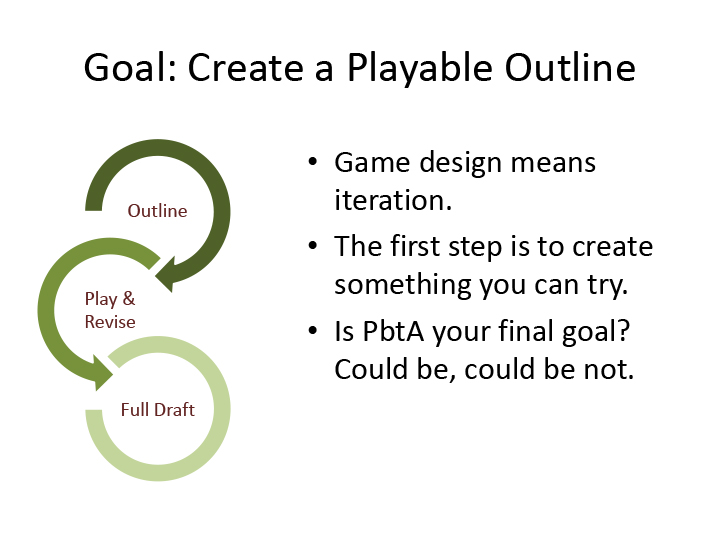

Teori-inblick #161 – ropeblogi says:
[…] Powered by the apocalypse, part 11: Dice av Vincent Baker visar att tärningar kan användas på olika sätt i PBTA-spel. https://lumpley.games/2024/04/29/powered-by-the-apocalypse-part-11-dice/ […]
jochen says:
It’s interesting that the Ironsworn-family is sometimes not considered PbtA because “it doesn’t even have 2d6+stat” 🙂 here, you prove that argument as false. Thank you!
I really like what Shawn did with his 1d6+stat vs 2d10 because it opens up so much potential for interpretation, especially considering the Cinder and Wraith oracle in Sundered Isles.
Edf says:
Hi, Do you have any examples of pbta using dice pool
Designer Diary for Planet of the Week – Troy Press says:
[…] Source: Vincent Baker, Powered by the Apocalypse, part 11: Dice […]